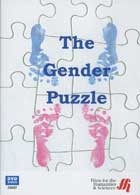
The Gender Puzzle 2005
Distributed by Films Media Group, PO Box 2053, Princeton, New Jersey 08543-2053; 800-257-5126
Produced by Janine Cohen
Director n/a
DVD, color, 46 min.
College - Adult
Gender Studies, Social Work, Sociology, Psychology, Biology
Date Entered: 12/12/2006
Reviewed by Cindy Badilla-Melendez, University of St. Thomas, St. Paul, MN“Standard” sex chromosomes (XX or XY) used by scientists over the years to identify gender are no longer reliable. Determining gender in people is getting more complex. About 40,000 Australians do not have these “standard” sex chromosomes. One in 500 boys is born with xy chromosomes. Most have standard genitalia and are unaware that they will not be able to have children. One in 500 people has some sort of chromosome variation.
Up to the 1990’s gender was thought to be defined by chromosomes until the study for people with intersex conditions began. The gene SRY was discovered. The SRY gender gene is located in the brain where identity is developed. This gene is also present in the male region of the hypothalamus.
Formerly, doctors made decisions for parents and babies and assigned the sex they thought would be the best to any baby born with either ambiguous or atypical genitalia. For years psychologists thought nurture would help define gender. The feminist theory was that females were limited because of stereotypes and socialization. If researchers rely on the scientific chromosomes for what makes a male or a female XX or XY, many people would be from the opposite sex.
In the United States 94 intersex people with the condition of atypical genitalia were surveyed. More than half were unhappy with the sex they were assigned. Several females who were raised as girls and had genital surgery as babies later became males. Many of the 94 interviewees reassigned their gender later in adulthood.
In a Dutch study similar features of female brains were found by looking at the hypothalamus of six male to female transsexuals. They examined the part of the brain essential for sexual behavior and found the same size in female transsexuals as it was in other women. In men this region of the brain known as “bed nucleus of the stria terminalis” is much larger. The study suggested that gender identity develops as result of an interaction between the developing brain and sex hormones. Researchers are discovering that transsexuals have the body to match their chromosomes but believe their brain is “hard wired to go in the opposite direction.” According to public perception, transsexualism is a life style choice not a biological error.
Currently, in Australia, children seeking medical treatment to change genders must have permission from the Family Court. Part of the treatment for children is puberty blocking hormones that will delay the hormone process. Puberty blockers are reversible and could save a child from harming him/her self. Religious organizations oppose any form of treatment.
Throughout this documentary, several people born with either ambiguous or atypical genitalia are interviewed. They were assigned a sex by doctors at the time of infancy, sometimes their parents knew about it others were never asked. These individuals talk about their feelings, frustrations, legal issues, and how the condition has affected their lives.
This film is one of the most complete and well based films covering the biological, scientific, psychological and personal approaches on the topic available as of today. There are other films such as Gender Trouble (Seventh Art Releasing, 2002); Transgeneration (New Video, 2005); Changing Sexes: Female to Male (Discovery Channel, 2002); Transgender Revolution (New Video 1998) that are good, but do not cover all these aspects and they are not as updated.
The picture and sound quality are very good. The film is in English with closed-captions. This video could fit the subjects of gender studies, social work, sociology, psychology, and biology.